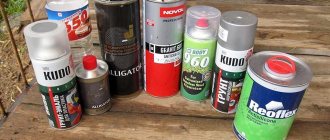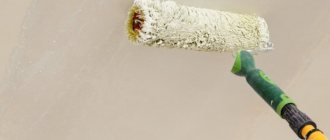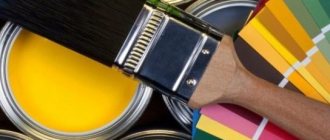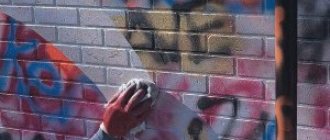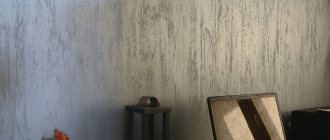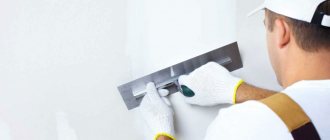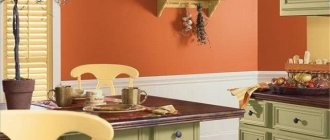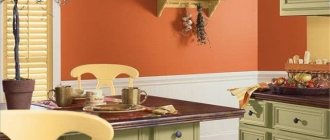What do they paint?
As a rule, coloring compositions are applied to:
- Smooth or decorative plaster;
In the second case, the work process is clear: you cover the walls with wallpaper and paint them in the desired color. If we are talking about plaster, then you will have to work hard.
Additional recommendations
Advice from experienced craftsmen will help you do all the work correctly:
- Before performing extensive work on preparing the walls, practice on a small area of them.
- Apply each subsequent layer only after the previous one has dried.
- Do not dilute the putty in large portions.
- When drying the applied layers, avoid exposing them to hot air currents or direct rays of the sun.
- If any textured surfaces (fiberglass, plaster) are painted, they are also primed. Moreover, special adhesive-based compositions are selected for wallpaper.
Knowing how to prepare walls for painting with your own hands , you can save a lot on the services of professionals.
Write in the comments: How did you cope with preparing the walls for painting on your own?
Features of acrylic paints for walls
Despite the many technologies for applying images to vertical surfaces in residential premises, acrylic wall paint is the most popular, even compared to photo wallpaper, mosaic or tile.
In this case, many are guided by the characteristics of this material. It consists of:
- coloring pigment;
- water;
- acrylic resin, which acts as a binding element;
- stabilizing and modifying additives that significantly improve the performance characteristics of the paint.
Wide color palette
In addition, the material has the following positive characteristics:
- ease of application;
- acceptable price;
- wide range of colors;
- the ability to mix colors to create new shades, which allows you to paint walls at a professional artistic level;
- acrylic paints for finishing allow you to create both complex compositions made by professional artists and the simplest drawings created by novice artists;
- quick drying after application and minimal time between painting and the start of use of the surface;
- acrylic paints for wall painting are resistant to moisture and ultraviolet rays, its surface after drying is quite durable and resistant to various types of mechanical stress; After the paint dries, the wall will resemble plastic in structure, this is facilitated by the special composition of the material;
- frost resistance;
- painting walls with acrylic paint is completely safe, since the material has low toxicity;
- durability of the coating: products from well-known brands can be used for 15 years.
Acrylic paint for walls is perfect in cases where high-quality and original decorative design of surfaces is required.
Applying paint to the wall
To get the maximum effect from using the material, proper preparation of the walls before painting and following the application technology are required.
Acrylic paints are tinted using special mixtures, thanks to which it is possible to achieve different concentrations of a particular color, as well as create new shades.
Thank you for reading our article!
Rate the quality of the article on a scale from 1 to 5.
Add a comment Cancel reply
Alexander / 08/06/2019 16:21
My walls did not have any special defects. But I didn’t want to work laboriously. I found a way out. I took glass wallpaper for painting. I simply covered up the defects in the wall, pasted wallpaper and painted it.
Kirill / 08/06/2019 16:22
I simply removed the old wallpaper and primed the walls. When I saw all the flaws, I filled it with finishing compound. Then I painted it. All.
Source: nedvigdom.ru
To shoot or not to shoot.
Most people don’t bother with this at all, but glue new canvases directly onto the old wallpaper, which absolutely should not be done.
Firstly, if you have old wallpaper or the slightest fragments of it, the wall surface will never be ideal. In other words, immediately after pasting the new wallpaper, as they say, all the bumps and bumps will be visible.
Secondly, the old wallpaper can come off at the most inopportune moment along with the new ones - and all your work will go down the drain.
Thirdly, harmful bacteria and mold fungi often form under old wallpaper, which should be gotten rid of, and this is an additional hassle.
How to prepare walls for painting after wallpaper?
Nowadays you can increasingly find interesting and easy-to-use facing materials, but this does not mean that consumers have given up painting walls. This decoration option is quite simple, and besides, when using it, you can fully express your imagination. Interesting and rich shades can completely transform the room. But everyone knows that paint cannot hide imperfections on the surface. Therefore, it is important to know how to prepare walls for painting after wallpapering.
Essential tool for removing wallpaper from walls
Now it's time to prepare your tools and materials. To remove wallpaper and clean up after dismantling you will need:
- broom and dustpan;
- Trash bags;
- sponges and rags;
- bucket, detergent and water;
- gloves, goggles and face mask;
- work clothes.
In addition, tools and accessories are collected:
- stepladder for working at height;
- several spatulas of different sizes with sharp edges;
- wallpaper “tiger”, knife or needle roller.
It is necessary to stock up on special tools, namely liquid for removing wallpaper. If this is not available, a solution of water and soap will do. Another option is to prepare a piece of fabric and a steam iron or, if you have one, a steam cleaner.
When everything is ready, you can begin dismantling the old coating. You can do this using one of the methods listed below.
Preparatory process
The walls, of course, differ in structure, and this must be taken into account when preparing. But most often the same procedures are performed:
- Level the surface.
- Get rid of imperfections using putty.
- Clean and prime the surface.
Alignment
To prepare walls for painting after wallpaper or other material by leveling, the surface can be:
- Grind. You can grind a fairly strong base, the level of which changes by no more than 2-3 mm. In addition, it should not have significant defects. This removes the old coating and a small layer of plaster underneath. To do this, use a simple tool: a block with sandpaper wrapped around it.
- Level with plaster. If there is significant curvature of the surface, plastering along the beacons or finishing with drywall is performed.
Important! After the leveling procedure, the walls must be primed and dried for six to seven hours.
- Use drywall sheets. The simplest and at the same time effective way by which you can even out even very crooked walls.
Important! The only caveat when using plasterboard sheet material is a large “cut” of the usable area of the room.
Puttying
The first layer is applied with starting putty, which is sold as a ready-made solution or dry mixture. To apply the starting putty, a fiberglass painting mesh is used:
- Apply 2-3 mm putty to the surface using a wide spatula.
- A narrow spatula is used to smooth out small ridges and spread the solution.
- We put a painting mesh on the wall and rub it into the putty using a spatula.
- Apply starting putty to the mesh with a layer of 2 mm.
- Dry the surface for 5-7 hours.
- We rub down the wall.
Important! Finishing putty is used to get rid of the marks left by coarse grout. Its consistency is uniform and finely dispersed, so the surface ends up being perfectly smooth. In addition, paint does not absorb much into it.
The finishing putty is applied in the same way as the starting putty, but its layer will have a different thickness. The optimal layer thickness is considered to be 1.5-2 mm. When the surface is dry, it needs to be sanded using fine-grained sandpaper.
Padding
To ensure that the process of preparing walls for painting after wallpaper is of high quality, the surface must be primed before applying the decorative solution.
Important! Before applying the primer, the resulting construction dust should be removed from walls covered with finishing putty. To do this, use a vacuum cleaner, dry rags or a soft brush.
Acrylic primer has gained the most popularity. It is universal and can be applied to almost all surfaces.
For priming use:
Important! This coating should dry for 4-6 hours.
After this you can start painting. If the walls were covered with paper, it is important to learn how to paint the walls after wallpapering.
Part I: removing wallpaper
What you need
- Film;
- Mask or respirator;
- Putty knife;
- Cord brush;
- Paint brushes;
- Wallpaper steamer;
- Ladder;
- Bucket and sponge;
- Wallpaper removal solution;
- Putty.
Why you shouldn't paint over old wallpaper
In some cases, this option seems to be the only option, but it is usually temporary. For example, you bought an apartment, set a date for renovation, but it’s not tomorrow, and the idea of living a “flowery” life is perceived as aesthetically unacceptable. Remember: in the future it will take much more effort to remove wallpaper primed in this way: when paint is applied, it becomes waterproof, and you will need special tools to work with it. We will tell you which ones below.
If there is no question of spontaneously painting the wallpaper over the pattern, then the wallpaper can be safely removed. Firstly, this will make the surface of the wall smoother and easier to accept the new coating, be it putty, primer, plaster or paint itself. Secondly, this is the only way to remove the “cultural layer” that certainly accumulates under the wallpaper: dust, whitewash, small fractions of cement, mold and other unpleasant formations.
Preparation for the process
We start with preparatory work: we cover the surrounding area with a protective film. We pay special attention to the area of sockets and switches, close the wiring (just in case, you can turn off all the “automatic machines” on the panel). We wrap furniture and lamps with film if they have not been removed. We put on a respirator or mask, gloves and work clothes. Do not have illusions about your accuracy: repair compounds have a completely different view of things.
Removing wallpaper: the old fashioned way
If the wallpaper is really old, made of paper, and is peeling away from the wall in places, you can try to carefully “pick up” it with a spatula: sometimes old coatings can be easily removed. It’s another matter if the wall has been pasted layer upon layer for decades. In this case, there is a risk that the spatula will either not remove the wallpaper at all, or will remove it from sections of the wall. Therefore, to the question: “Is it possible to remove wallpaper from a wall with your own hands?” the answer will be: “Yes, you can, but it’s better not to risk it.”
Removing wallpaper: using a solution
The solution for removing wallpaper is usually mixed with alkali or a mixture of solvents. The composition exists in the form of liquid or powder. When treating walls with such a product, be sure to use a mask, since the liquid can be caustic. Please note that heavy textured wallpaper or wallpaper applied in several layers usually require several treatments, and one bottle may not be enough.
An analogue of such a solution is sometimes made at home: the composition is based on vinegar, water and washing powder. However, given the relatively low cost of factory-made solutions, it is hardly worth the effort. Moreover, washing powder is also a chemical composition.
Removing old wallpaper
Of course, there are some features that need to be taken into account to ensure a smooth surface.
Important! After removing the wallpaper, there will be glue left on the wall, which is not so easy to remove. But if it remains, the painting may not be successful.
To clean the surface proceed as follows:
- To remove duplex or paper wallpaper, soak it. To do this, use a wet rag or sponge. After half an hour, the paper base is removed using a spatula. If necessary, the procedure is repeated.
- On acrylic, non-woven and vinyl wallpaper, first get rid of the top moisture-proof film. Then you need to proceed as described in the paragraph above.
- The remaining adhesive solution is removed using a spatula.
- A thin layer of primer is applied to the scratches that appear, and then finishing putty.
Important! In order for a metal spatula to become a good scraper, its blade is shortened to a length of 2-3 cm. You can use old tools - the blade is made of thick and stiff metal.
Now you know how to prepare walls for painting after wallpapering.
Removing ceramic tiles and plaster
Cracked plaster coating must be removed to avoid future problems. The old layer will begin to crumble over time and ruin the appearance of the painted wall. Preparing plastered walls for painting will become much easier if the old coating is of high quality and in good condition.
If there are obvious cracks on the surface, then for cleaning you only need a metal spatula, which can easily pick up the separated pieces.
If the coating is high-quality and dense, you will need a hammer drill with a special attachment. If a hammer drill is not available, use a chisel and hammer. This method is also suitable for removing ceramic tiles from prepared surfaces.
The plaster can be removed using a professional sanding machine with a construction vacuum cleaner connected to it. With this device, time is saved and the room is less dirty.
After removing such coatings, the wall requires more thorough preparation for painting. The walls will require leveling and should be re-plastered.
There are a number of reasons why it is imperative to prime the walls. These include:
- By impregnating the surface with a primer, it will be possible to obtain a binding element. The surface to be pasted will be free of dust and will stop crumbling.
- This will prevent the appearance of mold and mildew.
- The primer will fill microcracks on the surface of the wall, making it much stronger.
- The primer increases the level of adhesion.
The primer material is best applied to the surface to be glued using a roller. Hard-to-reach places can be treated with a brush. If the composition is absorbed by the wall, another 2-3 additional layers are applied.
How to get rid of paint?
But what to do if you need to remove the paint itself? It is also quite difficult to cope with:
- Sometimes in this case they use a metal brush with short bristles. But it will not always help, since it can only smooth out the paint layer.
- Most often, it is more effective to use a set of nozzles, which includes scrapers of different shapes. To make them yourself, chisels, wide screwdrivers and spatulas are used.
- To facilitate and speed up the process, use a special nozzle. It looks like a rod with short chains attached to it. A few links will be enough. It needs to be inserted into the drill chuck and clamped. The drill should be parallel to the surface being cleaned. When the drill starts to rotate, the chains will simply knock off the paint.
- You can also use special chemical removers, but they must be used in compliance with all safety measures and instructions from the manufacturer. They give the effect of removing old coating quite quickly.
Important! If paint will be applied to the wall again in the future, it must first be puttied.
We use water
Procedure for removing water-based paint
Of course, rinsing is not carried out with water from a hose, so you will also need some tools:
- A high stool, and if the renovation is being done in a Stalin apartment, you will need a stepladder.
- Narrow and wide metal spatula.
- Wide water container.
- Roller with a long handle.
- Respirator and glasses.
- Metal brush.
Cover the floor with newspapers or plastic wrap.
How to wash off ordinary emulsion
- You need to fill the prepared container with warm water.
- Wearing glasses, dip the roller in water and use it to wet the area of the wall where the paint will be removed.
- In addition to glasses, after 15 minutes, also put on a respirator and begin to remove the soaked paint with a scraper.
- If there are places where the paint does not come off, then the soaking procedure must be repeated. If this time it didn’t work out, then you can use a metal brush.
- Having finished cleaning the intended area, you can move on to the next one.
Wash off the waterproof emulsion
The algorithm for removing waterproof emulsion paint will be as follows:
- If after wetting the paint does not get wet, it means that it is moisture resistant and therefore needs to be scratched with a metal brush, removing the top layer.
- Now the wall fragment needs to be moistened several times with water at intervals of 10 minutes. This procedure is performed until the paint swells and becomes pliable.
- Next, the cleaning process is the same as in the previous case.
Using glue
Many people are familiar with the picture when, when removing wallpaper, the coating applied to the wall comes off along with it. Now we will use this method to remove the water-based emulsion.
- We will need regular paste or wallpaper glue and newspaper or old unnecessary wallpaper.
- Glue is applied to the paper, after which it must be firmly glued to the wall, otherwise all the paint will not come off.
- After our improvised wallpaper has dried, it is removed by prying it off with a spatula.
- All that remains is to look through the wall and remove any remaining paint with a spatula or brush.
As with oil paint, you can use a grinder or hair dryer to remove a thick layer of emulsion.
Chemicals
There are many effective preparations on sale designed to remove water-based paint. Unfortunately, they are unsafe and can cause harm to human health if the manufacturer’s instructions are not followed. Although the instructions for use may differ slightly depending on the manufacturer, it boils down to one thing - the product is applied to the wall (except plastic), and then after 10-15 minutes it is removed along with the paint.
How to prepare walls for wallpaper for painting with your own hands: step-by-step instructions, video
We advise you to take the main topic of our conversation very seriously: how to prepare walls for wallpaper for painting with your own hands .
It’s definitely not worth calling specialists for such work. Preparing walls for wallpaper for painting is done on your own. Even an inexperienced person will be able to cope with the entire volume of work.
Why is preparation important?
The benefits of preparatory work should not be diminished. They play a great role in further work and the quality of the result obtained. If the walls are not prepared for wallpaper for painting at all, then the following troubles may appear on the surface of the wallpaper after painting:
- cracks;
- spots;
- uneven color change;
- clear viewing of wall defects (chips, cracks, pits and bulges).
It's a sad picture, isn't it? Especially when you consider the wasted money and wasted time. Such negative aspects can appear even on expensive wallpaper and premium paint. If you think that the surface looks decent and can do without preparation, then you are not immune from incidents.
We hope that the arguments described above have convinced you to carry out surface preparation. If this is the case, then you can move on to the next stage of the conversation. It will describe in detail the preparation of walls for wallpapering for painting.
Mistakes when painting wallpaper: what not to do
Those who paint wallpaper for the first time often encounter problems with uneven application of the coloring composition and other defects. This is due to mistakes that should not be made. Let's look at them.
- Wrong choice of wallpaper. If the wallpaper is not intended for painting, it will begin to decompose under the influence of the pigment. The coloring will either not work at all or will look splotchy.
- Uneven paint application. If you paint the canvas with a brush or use incorrect movements with a roller, streaks will occur; some layers will be thicker and some thinner.
- Neglecting recoating. If you apply paint in just one layer, then over time some stains will begin to appear and the wall will not look monochromatic and stylish.
- Lack of preparation of canvases. If the surface to be painted is not first cleared of debris, then grains, pellets, and hair will begin to appear during the application process. Getting rid of them is problematic without damaging the pigment.
- Use of one nozzle. When painting, you need to try several roller attachments and the wider they are, the more convenient it is to apply layers. Any layer that you don’t like is better to redo right away, then repainting and maintaining the structure is problematic.
vote
Article rating
Surface preparation steps
There are no difficult moments in the upcoming work. The main rule concerns the consistent implementation of all stages and listening to advice.
Preparing the premises
The essence of this stage is to remove the furniture and dismantle the baseboards. It is also recommended to cover the floor with polyethylene. The protective film should also be placed on the windowsill and window. Such precautions will provide protection for expensive elements and reduce the time required to clean the room. Sockets must be de-energized for safety.
Working with the surface
The initial preparation of walls for painting after wallpaper involves removing the old decorative coating. There should be no wallpaper, paint or other covering. Wallpaper intended for painting cannot be pasted onto such a surface. Vinyl and non-woven fabric will not stick at all, and other wallpaper options will come off after a short time. You shouldn't tempt your fate.
We identify and remove fungus
Preparing walls for painting after wallpaper must include this item. If the fungus is not identified and removed before wallpapering, it will certainly appear on the finished wall in the future. The fungus loves to live in corners, so these are the places that need to be carefully examined. When these harmful organisms are identified, it is necessary to treat the surface with special means, but first it is necessary to remove the layer of old plaster along with the primer.
Moisture Test
Many builders simply underestimate this stage. Very in vain, by the way. If the wall is damp, the wallpaper will not adhere well and will eventually fall off. Especially after re-painting. And the likelihood of fungus appearing on wet surfaces is much higher than on pre-dried ones.
To determine the presence of high humidity in the wall, it is necessary to conduct a simple experiment. We take a small piece of cellophane and glue it on all sides to the wall with tape. Leave the structure in this position for 12 hours. If drops of water appear on the cellophane, then the wall needs to be dried.
Removing wallpaper
This activity is associated with disorder. Therefore, it is best to move all the furniture to another room, and protect the floor and other elements, such as contacts, sockets or window sills, with film and masking tape. Thanks to this, you can avoid getting glue and debris on them, and also get free space in which you can work freely. It is equally important to equip yourself with the appropriate tools: a joint knife, a spatula, sandpaper, a bucket, a sponge, a paint roller, a brush or a brush.
Wallpaper can be removed dry - by hooking it from the corner with a spatula, tearing it off the wall. But this is a very labor-intensive task and you need to be careful not to damage the plaster. Therefore, it is better to remove wet, moistened with water or a special preparation.
To do this, you need to completely saturate them with a damp sponge and wait until they soften, and then remove them. You can also use a spray bottle filled with water, wait until the wallpaper absorbs the moisture, and then peel it off the wall. If some fragments do not move away from the base, you need to repeat the action, and sometimes even several times.
To quickly and efficiently remove wallpaper from any wall, it is recommended to use a special preparation - wallpaper remover. The product is intended for all types of wallpaper (paper, vinyl, glass). It comes in the form of a concentrate, which must be diluted with water in the proportions specified by the manufacturer. Apply the prepared solution to the wallpaper with a brush or roller. The agent is absorbed into the wallpaper, dissolving the glue, making it easy to remove the wallpaper from the wall without damaging the plaster. For convenience, you can cut the wallpaper with a knife in several places so that the solution penetrates better inside. The best way to remove wallpaper is to pull the top corner down at a slight angle.
